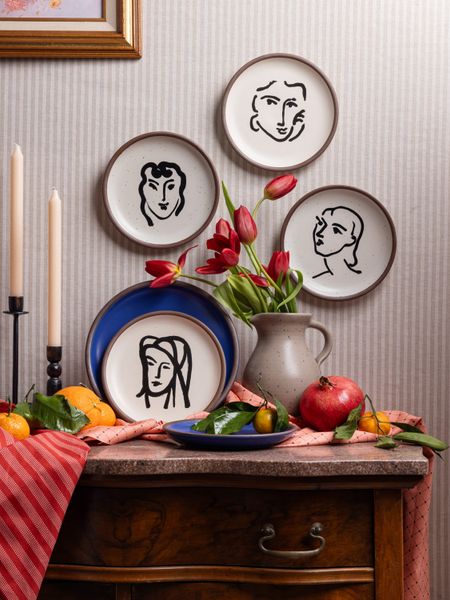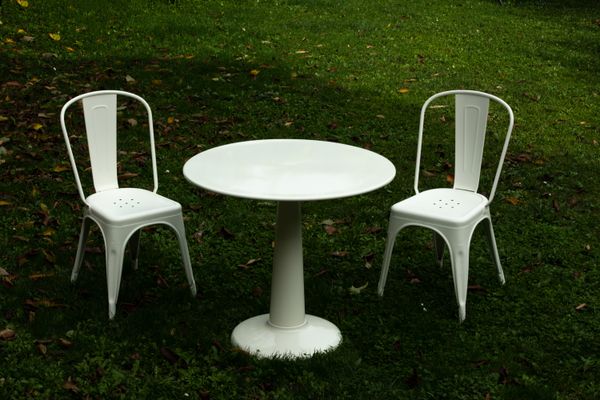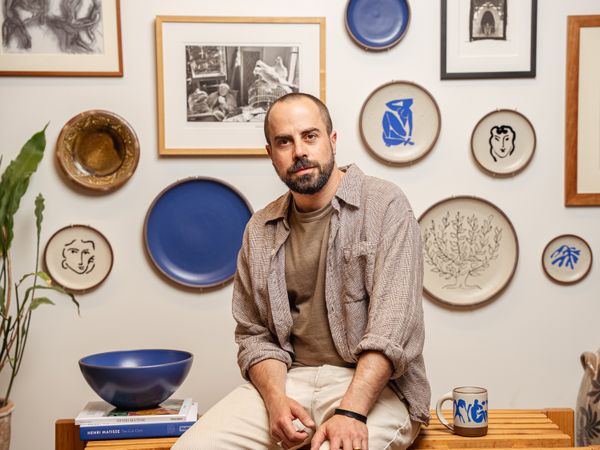Frida Kahlo has a new line of rugs. East Fork made a collection with Henri Matisse’s art. When work becomes public, estates are left to navigate honoring a legacy that anyone can commodify.
Welcome to Field Guide, a column by Sami Reiss of Snake covering all-time design and where you can find it.
For a while Alex Matisse, the great-grandson of French artist Henri Matisse, ran away from family tradition. "I fell in love with clay as a medium" in fifth grade, he says. He tried to "drop it" in college but eventually found himself back at it. "I moved to the mountains of Asheville, North Carolina," he says, to "find my own way and do something that was outside of the Matisse family legacy, and East Fork was what emerged."
Over the past decade and change, the ceramics company has created a name for itself by producing limited-edition pieces, offering competitive salaries, and using "radical transparency" on Instagram and in their marketing. The past few years have seen collaborations with Fishwife, the tinned seafood company, and popular chef Molly Yeh. For a long time, Alex says, "so many people had no idea there was any relationship to the artist."
Earlier this year, however, Alex made the connection very public when East Fork launched a collection featuring Matisse’s work on serving platters, mugs, bowls, and plates. Alex says the collaboration with Les Heritiers Matisse, the family’s partnership company, started once East Fork was "cemented in hearts and minds," and that it focuses on work from paintings—Matisse’s clouds, his deep blues—that "translate well to the process" of pottery, done in the East Fork way. "Putting together this collection was deeply personal and connected me to his work and legacy in a way that I hadn’t been before," Alex says.

A collection of side plates in a panna cotta colorway from East Fork features aquatint portraits Henri Matisse made in the late 1940s.
Courtesy of East Fork
But the timing of the release was more than just a homecoming of sorts for Alex. The new pottery came just as his great-grandfather’s work entered the public domain this past January, when he and the artist’s heirs’ compensatory right to licenses of his work ended. If not explicitly, the new collection stands as an example of how an estate or family might manage this transition, where, once artwork or a design loses its copyright protection, it’s able to be licensed and produced more easily than before—think pens or calendars from a museum gift shop.
In America, works of art, literature, and ideas, which includes works of design, enter the public domain and enter a royalty-free space on January 1st of each year, 70 years after the death of a relevant artist. (Other notable expiring copyrights recently: Walt Disney’s Steamboat Willie in 2024, Che Guevara’s likeness in 2018.) To be sure, contract specifics matter, and so not everything that predates the 1950s is able to be slapped onto a bumper sticker or hat. Ultimately, though, characters and pieces free to be referenced and used show up in more places. Think of Frankenstein's Monster and Dracula, two characters whose compensation rights expired long since before their cereals or cartoons.
There might not be another artist whose work or likeness is so ubiquitously commercialized as Frida Kahlo’s, licensed or otherwise. A new swath of her output entered the public domain in January of this year, and now, there’s at least one new rug collection from the Frida Kahlo Corporation, which, according to its spokesperson, Beatriz Alvarado, safeguards her "name, image, and likeness," including any intellectual property it has built around her. "Our responsibility is to ensure that whenever Frida’s name is invoked in commerce, it honors her values and spirit," says Alvarado. "It is also to carry forward her plea, written in her letters ‘no me olvides.’"
The release, a partnership with Tumble, a company that produces washable rugs, includes five spill-proof, kid- and dog-friendly designs inspired by Kahlo’s "paintings, textiles, and home life in Mexico City." When asked how the collection expands on the artist’s legacy, Alvarado explains that it "reinforces something essential about Frida: she never separated art from life. Her home was her studio, her clothing was her canvas. By treating design as an extension of living, this collection makes her legacy tangible for new generations."
In the world of furniture specifically, public domain often leads to a situation close to a dupe, or a vaguely familiar stool that’s now in every new taco place. The best example might be the Tolix A chair. If you’ve ever gotten tacos in a restaurant with exposed brick walls and bare wiring, then you’ve seen it. Originally designed by Xavier Pauchard in 1935 for the company Tolix, it’s a stainless-steel chair, water resistant, simple and metal, round at the top and hollow in the back. It quickly became a favorite in French cafes when its copyright elapsed in 2018. The Tolix A is not quite as prolific as the Monobloc chair, but it’s cheap enough to reproduce that the design—already everywhere in Europe a decade ago—litters restaurant supply websites for a fraction of the real iteration’s original cost. Nearly meme-worthy, it’s been referred to as the "everywhere chair," and is in so many places because its design is no longer copyrighted.
Even without paying a license, there’s a significant cost to duplicate a chair at scale. And furniture is hard to copyright even when protections exist. "To a large extent," says David M. Adler, an Illinois-based intellectual property lawyer who counsels designers and furniture companies, "a chair is a chair, and a table is a table." Which is, in design, the difference between a trademark—a logo, a brand name, a public identity—and a copyright, which refers more specifically to the item’s design. Furniture has existed for millennia, and it’s "hard to say," whether how a chair or a table looks, says Adler, "is so original and creative that nothing like it can exist."
The protections for works still retaining their copyrights are dealt with on a case by case basis, says Adler. He gives an example regarding the design of Charles and Ray Eames’s Galaxy light; it may receive copyright protections for the 3D design, and its metal tubes may be considered art. But it depends on the lawyer and on the judge. Then, when you take into account international markets, things get more complicated. You see so many Tolix A chairs that just look like the original and Eames dupes because they’re imported. "Overseas manufacturers who infringe are outside reach of domestic businesses," says Adler, and "they get away with it because it’s hard to enforce American IP laws abroad." Still, goods may be seized at the border—or destroyed—if the copyright is valid, and if the company has done its paperwork. The copyright-expired item, though, may be easier to import.

The Tolix A chair, designed by Xavier Pauchard in 1935, has been heavily copied, especially since its copyright expired in 2018.
Courtesy of Tolix
In the art world, there’s more licensing: It’s the canonical paintings that end up on T-shirts and pens. One way to get around that might be to go the licensed route, which East Fork has done. For the Matisse capsule, Alex chose later-era works, including the artist’s fluid-line portraits on side plates, and other series—Nu bleu, La Perruche et la sirène—on other items; the pottery came out this summer.
With Matisse’s work now more exposed, bringing a critical eye to the East Fork collection was crucial in setting it apart from what might appear on gas station tchotchkes. The East Fork collaboration began three years ago, before the copyright expiration, with Les Héritiers Matisse acting as point. The family, known to be exacting regarding how the artist’s work gets expressed, put the items through the ringer. "We knew there would be extra scrutiny" from Les Héritiers on the collaboration, says Alex. His brother Georges managed the collaboration—"back and forth, back and forth, back and forth, iteration after iteration"—and put the samples through revisions, since "anything done by the family needs to be at a certain level." (One senses a bit of a coach’s son situation from one brother holding another to a high collaborative standard.)
The result is a collection that’s reined in, done with appropriate attention to detail, and decidedly apart from what might come down the pike that uses images from Matisse paintings produced during the artist’s life. (It’s already begun: a collection of Matisse-blue colored clothing, by an unaffiliated brand, released in July of this year.) There’s a way, though, to depart from a future of what Alex calls "shower curtains and coffee mugs," maybe through a family connection, but definitely through embracing the work.

East Fork cofounder Alex Matisse poses with the ceramics company’s Matisse collection.
Courtesy of East Fork
See the full story on Dwell.com: From Cheap Souvenirs to Handmade Ceramics: What Happens When Copyright Runs Out
Related stories:
- Here’s Every Stop at the 2025 Edition of Austin’s Famous Homes Tour
- Ikea Snags Nike’s NY Flagship Store for $213M—and Everything Else You Need to Know About This Week
- Mexican Design Is Ready for Its Close-Up
Read More
By: Sami Reiss
Title: From Cheap Souvenirs to Handmade Ceramics: What Happens When Copyright Runs Out
Sourced From: www.dwell.com/article/how-designer-and-artist-estates-navigate-public-domain-east-fork-henri-matisse-c0b5015d
Published Date: Fri, 10 Oct 2025 12:02:20 GMT
.png)





